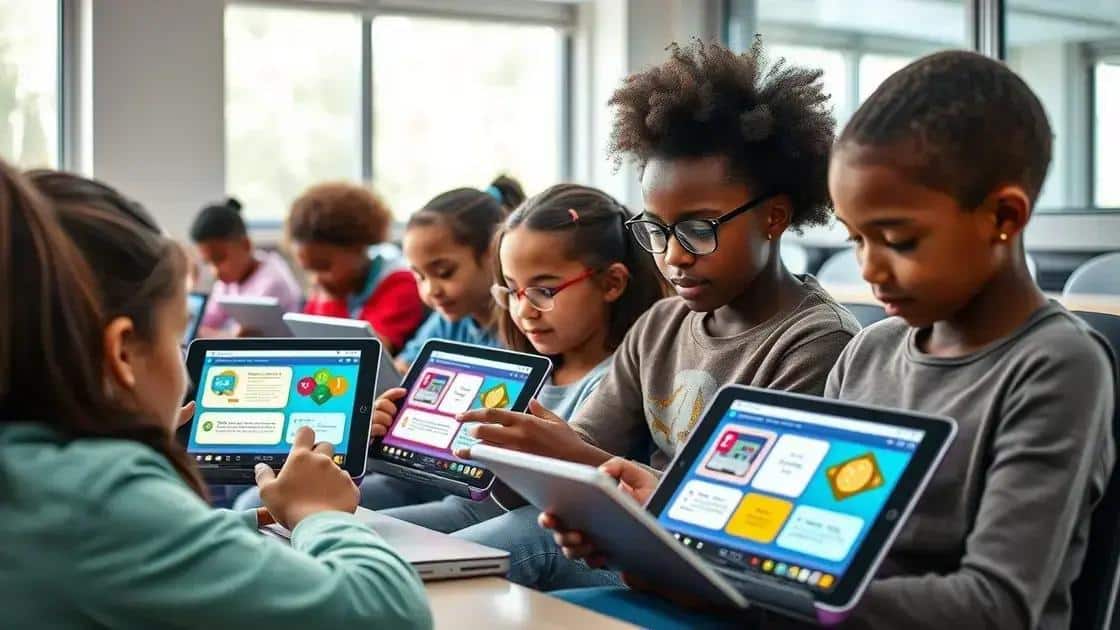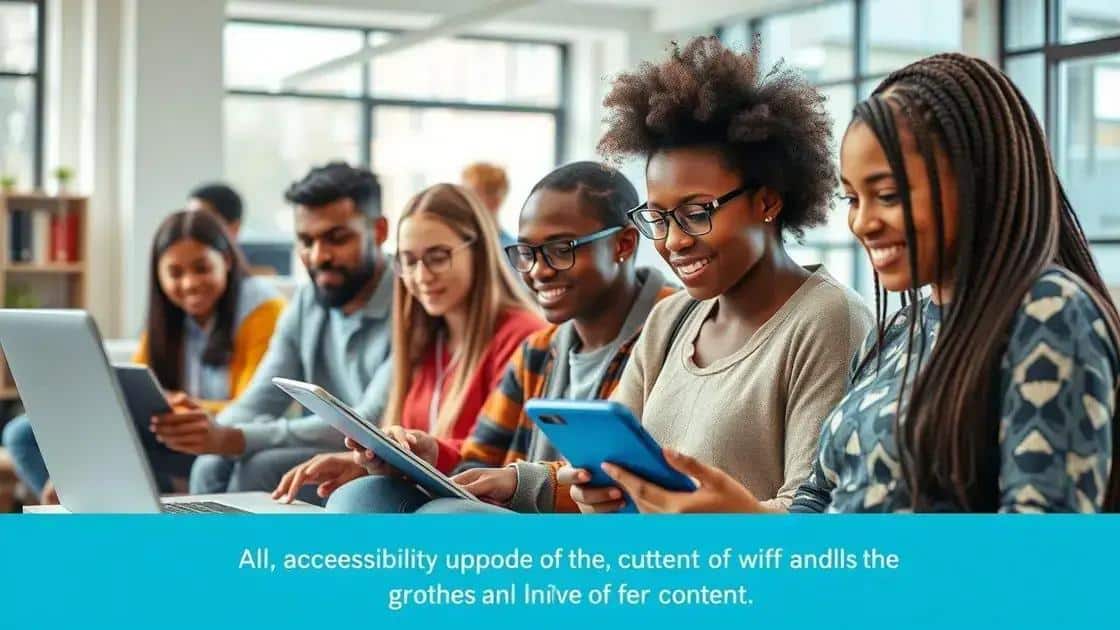What’s new in online course trends: top developments to watch

Emerging online course trends, such as microlearning, personalized learning, and enhanced accessibility, are transforming education by making content more engaging and inclusive for diverse learners.
What’s new in online course trends? The world of digital education is evolving quickly, and it’s fascinating to see how these changes impact learners. Have you ever wondered about the latest innovations?
Emerging technologies reshaping online courses
Emerging technologies are changing the face of online education. In particular, innovations like virtual reality (VR) and artificial intelligence (AI) are creating new opportunities for learners. These technologies help create more engaging and interactive experiences.
Virtual reality in education
Virtual reality offers immersive environments that allow students to explore complex concepts in a hands-on way. For example, medical students can practice surgeries in a virtual setting. This way, they gain experience without risks.
- Interactive simulations enhance learning.
- Students can experience real-world scenarios.
- VR can cater to different learning styles.
The integration of VR is transforming traditional learning methods, making them more effective.
Artificial intelligence enhancing learning
Artificial intelligence is another key technology reshaping online courses. It can analyze student performance and adapt learning materials accordingly. This personalization helps students learn at their own pace.
- AI-driven tools provide tailored recommendations.
- Real-time feedback helps improve understanding.
- Automated grading saves instructors time.
As AI continues to evolve, it will further enhance the learning experience, making online education more accessible and efficient.
By leveraging these technologies, educators can create dynamic learning environments that engage students and enhance their educational journey. As these emerging technologies become more commonplace, we can expect to see even more innovative approaches to online courses.
Personalized learning experiences in digital education

Personalized learning experiences are becoming a cornerstone of digital education. With tailored content, students can learn in ways that suit their individual styles and needs. This approach fosters greater engagement and helps learners achieve their goals more efficiently.
The importance of customization
Customization allows students to advance at their own pace. Each learner has unique strengths and areas for improvement. When educational platforms adapt to these differences, students feel more confident and motivated.
- Adaptive learning technologies assess student progress.
- Content can be tailored to fit specific learning styles.
- Students enjoy a more relevant and effective learning experience.
As a result, customization in online courses leads to better outcomes. Personalized lessons keep learners engaged, and they often retain information longer.
Tools for personalized learning
There are many tools available that support personalized learning experiences. Learning management systems (LMS) can track progress and provide insights. These platforms often include adaptive quizzes and resource recommendations based on student performance.
- AI algorithms suggest content based on learning history.
- Interactive activities cater to various learning preferences.
- Feedback is delivered promptly to keep students informed.
As technology advances, the ability to create customized learning paths will continue to grow. This ensures that every student can access a learning experience that is just right for them.
The rise of microlearning and bite-sized content
The rise of microlearning and bite-sized content is transforming how we approach education in the digital age. With busy schedules, students often find it challenging to commit to long study sessions. This is where microlearning steps in, offering quick, focused segments of information that enhance retention and understanding.
Understanding microlearning
Microlearning involves short, targeted lessons that are easy to digest. This approach makes it possible for learners to access information quickly, fitting learning into their daily routines. Whether it’s a video, an article, or a quiz, microlearning encapsulates the key concepts in under 10 minutes.
- Engages learners with concise material.
- Allows for immediate application of knowledge.
- Encourages frequent review to reinforce learning.
This format is especially popular in mobile learning environments, as students can learn on-the-go.
Benefits of bite-sized content
Bite-sized content not only caters to modern attention spans but also aligns with active learning principles. When information is broken down into manageable pieces, students can better focus and retain knowledge. They can revisit these segments whenever needed, reinforcing their learning experience.
- Enhances retention through repetition.
- Facilitates continuous learning and development.
- Can be easily shared on social media for wider access.
Incorporating bite-sized content into online courses can result in higher completion rates. As more students embrace this flexible learning style, educational platforms will continue to evolve, providing diverse and effective ways to engage with material.
Trends in online course accessibility and inclusivity

Trends in online course accessibility and inclusivity are reshaping education for everyone. Ensuring that all students can engage fully in their learning is vital. As technology evolves, educators are focusing on creating environments that cater to diverse needs.
The importance of accessibility
Accessibility in online courses means making materials available to all learners, including those with disabilities. This involves providing captions for videos, screen reader support, and materials in various formats. When courses are accessible, it fosters a sense of belonging for all students.
- Adjustable font sizes enhance readability.
- Color contrasts improve visibility for visually impaired learners.
- Easy navigation helps students locate resources quickly.
By focusing on accessibility, educational platforms ensure that no one is left behind.
Inclusive practices in course design
Inclusivity goes beyond accessibility; it embraces all aspects of diversity. This means considering different learning styles, cultural backgrounds, and experiences. By implementing inclusive practices, educators can create a richer learning environment.
- Diverse examples in course materials resonate with a broader audience.
- Active participation encourages voices from all students.
- Flexible assignment formats allow for unique expressions of understanding.
With inclusive course designs, every student can find value and relevance in their education. As we embrace these trends, the future of online learning will be more collaborative and supportive.
In conclusion, embracing trends like microlearning, personalized learning experiences, and accessibility will shape the future of online education. These approaches help create dynamic, engaging, and inclusive learning environments. As technology continues to evolve, education becomes more accessible to everyone. By putting students’ needs first, we ensure that everyone can thrive and succeed in their educational journeys.
FAQ – Frequently Asked Questions about Online Course Trends
What is microlearning?
Microlearning is a teaching strategy that delivers content in small, focused segments, making it easier for learners to absorb and retain information.
How does personalized learning benefit students?
Personalized learning allows students to engage with material at their own pace, catering to their individual strengths and learning styles.
Why is accessibility important in online courses?
Accessibility ensures that all learners, including those with disabilities, can access educational content and participate fully in their learning experiences.
What are inclusive practices in course design?
Inclusive practices involve creating courses that consider diverse backgrounds and learning preferences, allowing all students to feel valued and engaged.





